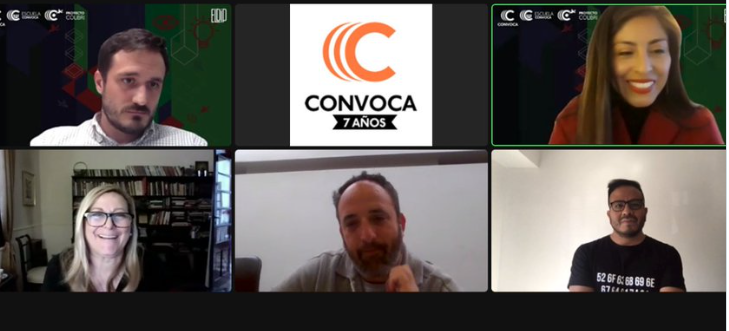The Peruvian news outlet Convoca.pe has become the epicenter of virtual events that serve as a collective space for dialogue on new technologies and journalistic investigations carried out in Latin America and Spain.
In mid-July of this year, Convoca.pe held the Latin American Conference on Data, Innovation and Investigative Journalism (ELDIP) with more than 30 speakers from around the world, 13 exhibition tables and four specialized workshops. Although the topics discussed were diverse, all the talks had the same goal: to understand how to make a good investigative story that combines technology and innovation.
“Every day, large volumes of information are generated that are rarely processed and analyzed by journalists and the media to detect stories of public interest and help citizens make better decisions. Therefore, it is essential that journalists know [how to use] key tools that enable the processing, analysis, verification, and visualization of massive amounts of information," explains the event's organizing team on the official website of the conference. "As well as being aware of new trends and digital narratives to develop stories that can have a greater public impact and benefit society," they add.
LatAm Journalism Review (LJR) attended the conference and summarizes below the highlights of the conversations that facilitate the creation of innovation teams and successful investigative stories.
Journalist and director of Convoca.pe, Milagros Salazar Herrera, talked about the importance of research teams having a clear common objective and the role each person plays in the work dynamics.
"It is very important to value the contribution of each member of the team, because this gives us the opportunity to speak a common language and listen to each other. Listening to what the other has to say is key," Salazar said at one of the panels.

The Latin American Conference on Data, Innovation and Investigative Journalism (ELDIP) began with the panel "Towards the future: data and innovation labs". (Photo: Screenshot)
Salazar also pointed out that within a team it is important to establish priorities in order to have clear agreements. And at the same time be flexible in case these agreements change during the course of a project.
In this respect, Sandra Crucianelli, Infobae's journalist and a thought leader in the use of databases in journalism, agrees. She favors agility and on the creation of stories based on data that do not take months to finish.
"Human resources are fundamental. The great challenge is to create a team that understands and communicates with each other and each person knows what to do," Crucianelli said in the conference’s opening statements.
One discussion theme that was constantly repeated during the conference is the need to publish stories that connect with readers, not leaving out the human story, even if you are making use of data or technology.
"If you are considering data work, the real story is out there. The story is not in the data or the visualization. The story is in the people being affected," Ronny Rojas, a reporter at Telemundo News, said. Rojas also recommended empathizing with readers, bringing the work closer to the people and personalizing it. Likewise, one must not forget tht street reporting is still necessary, despite advantages brought on by technology.
Journalist Rafael Quintero, from the data unit of El Tiempo newspaper in Colombia, also emphasized this issue. He said that the Colombian public is accustomed to the journalistic chronicle and the human aspect in feature stories, due to the influence left by writer Gabriel García Márquez.
"When you have a great story, and it is complemented with data, the story becomes more powerful. Not all data has to be complemented with a great story, but it does help readers become more interested," Quintero said.
Another factor that must be taken into account in order to generate public interest is the transmission of too technical information in simple language.
"The challenge [when you have technical terms] is to learn to identify stories and be able to speak of their importance in a simple way, with a language that is closer to the people," Jackeline Cárdenas, a journalist from La República in Peru, said during one of the conference panels.
At the opening panel entitled "Towards the future: data labs and innovation," Juan Cía, head of El Confidencial lab in Spain, opened the debate on building more useful media for readers. According to Cía, this can only be achieved through innovation and critical thinking within the news outlet itself.

Convoca.pe held the conference with more than 30 speakers from around the world, 13 exhibition tables and four workshops. (Photo: Screenshot)
"The El Confidencial Innovation Lab has been a trigger for change within the newsroom and a trigger for critical thinking. We work on being able to create workflows with teams that used to work separately in the newsroom [business, product, editorial teams]," Cía said. "Innovation labs have to be teams that foster corporate transformation within the news outlet, put readers at the center of decision making, [and] create more useful media for readers," Cía added.
At this panel, they also explained that innovation labs should not be understood as just a classic data visualization team, but as teams that manage data, technology, product, design, platform, among others. In addition, during the conference it was said that the best way to do a good job in the media is through integrated teams.
In that sense, the IT manager of the Pulitzer Center on Crisis Reporting, Ash Guevara, recommends that organization should be at the center of any teamwork. To do so, Guevara uses the scrum methodology where a sprint is established. A sprint is defined as a short fixed period of time in which a team works to complete a set amount of work.
"I don't agree with the media's separation between writers and design. In the media where they are doing better visualization work, everyone is considered a journalist. There is no separation. They are integrated teams," journalist and University of Miami professor Alberto Cairo said. "You have to make the relationship horizontal, not vertical. There must be a horizontal conversation. If that conversation doesn't happen, you will never become The New York Times."